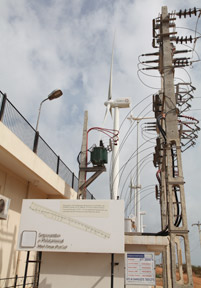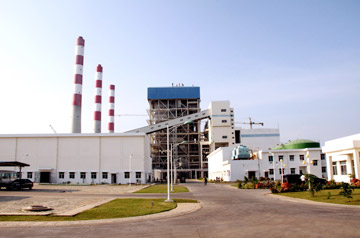Sri Lanka goes for alternative sources of energy
By Naalir Jamaldeen
The necessity for alternative power generation has been felt with the
increasing demand for electricity in the country. Several alternative
power generation projects have been implemented including coal and wind
power plants to cater to the increasing demand.
 |
|
A transformer at the wind
power plant. |
The power crisis is a major issue in the world especially in Third
World countries. Alternative power generation is not an easy task for
poorer countries due to the lack of technology and finance.
Several Western countries have shifted from hydro to alternative
power generation while Third World countries still depend on hydro
power.
Drafting a common mechanism to overcome the crisis is vital to
address the power crisis. In addition to hydro power generation certain
countries have focused on coal, wind and thermal power generation.
In the wake of averting a power crisis, Sri Lanka has also undertaken
alternative power generation in addition to hydro power generation. The
Norochcholai Lakvijaya coal power plant, the Puttalam wind power plant
and the Kerawalapitiya Yugadanavi Thermal power plant assists national
power generation considerably.
Meanwhile, the Government has implemented several major and small
hydro power projects at suitable locations. The Upper Kotmale project
takes significance. The Puttalam district is an appropriate location for
wind power generation. The wind power plants in the Puttalam district
adds 50 MW of electricity to the national grid alone, Wind Post Private
Limited has invested Rs. 4,000 million on the project, the technical
officer of the project, Arjuna Ratnayake said.
 |
| The
Norochcholai coal power plant. |
 |
| A sub line
from a tower |
 |
| Wind power
generating towers. |
Wind power plants have been set up in locations where the wind
velocity is high. These areas receive less rainfall compared to other
parts of the country. Rainfall accompanied by wind in these areas will
not affect electricity generation. In the event these areas experience
heavy rain, power generation will decline if heavy rains continue. there
will be a steady drop in electricity generation, Ratnayake said.
Three wind power plants - the Powerjeng, Nirmalapura and Daily Life
Renewable Energy (DLRE) function in various locations in the district
under the same company. The project was started in 2011, according to
Ratnayake.
He said that Seguwanq and the Widathamuni plants add 20 MW of
electricity to the national grid.
There are 12 towers in Seguwanq plant and 13 towers in the
Widathamuni plant. The maximum electricity generation capacity from each
tower will be 800 kilowatts. There is a general structure to maintain
the functioning of the towers and to detect faults, he said.
The increase or drop of power generation depends on wind velocity.
The Nirmalapura wind power plant is in Karamba and the Daily life
Renewable Energy (DLRE) generate 20 MW of electricity, each 10 MW. he
said.
The Wind Post Private Limited also plans to set up a 20 MW
electricity generation plant in Elephant-Pass, according to Ratnayake.
In the case of wind power. There is no excess expenditure except for
the cost of setting up equipment and the towers. The wind power plants
in the Puttalam district contribute to 30 percent said.
During the high wind season, the electricity generation capacity will
be high. Electricity generation will be high between May to August and
low between September to November. The shortage will be balanced by
excess generation of electricity when the wids are ate high velocity,
Ratnayake said.
Although wind power plants have relatively little impact on the
environment, compared to fossil fuel power plants, there is some concern
over the noise produced by the rotor blades, aesthetic (visual) impacts
and birds and bats being killed by flying into the rotors. Most of these
problems have been resolved or greatly reduced through technological
development or by proper sitting of wind plants.
Meanwhile, Norochcholai coal power plant also contributes to the
National Grid. Under the first phase, 300 MW of electricity and under
the second phase 600 MW was added Ministry sources said.
Plans are afoot to add 900 MW of electricity to the national grid by
the end of this year, according to Power and Energy Ministry sources.
The Norochcholai Coal power plant was financed by the Chinese
Government. US $ 455 million was spent for the first phase and US$ 891
million was spent for the second phase.
The Government of Sri Lanka spent Rs. 5,300 million for the first
phase and Rs.11,000 million for the second phase, sources said.
A jetty have been constructed with all facilities to ease the
unloading of coal. Two giant cranes have been set up to expedite the
unloading of coal, the sources said.
The sources said that 114 metric tons of coal is used for one hour to
generate electricity. An environment-friendly coal yard has been
constructed in the plant premises to ensure the protection of
biodiversity and the environment.
Coal required for three months can be stored in the yard. Coal with
less sulfur content is imported from Indonesia. A 117 kilometre- long
220 MW high tension line has been set up from the plant to Veyangoda
under the first phase to add to the national grid.
Under the second phase two turbines were set up and 300 MW
electricity was added to the national grid. A 100 kilometre long 220 MW
high tension line was set up from Norachcholai to Anuradhapura. A sub
station has been set up at Dummalasooriya, Chilaw.
Environment damage has been minimised in this instance. Mobile teams
also operate in the region to asses the changes taking place in the
environment and biodiversity changes to minimise the hazards. |


